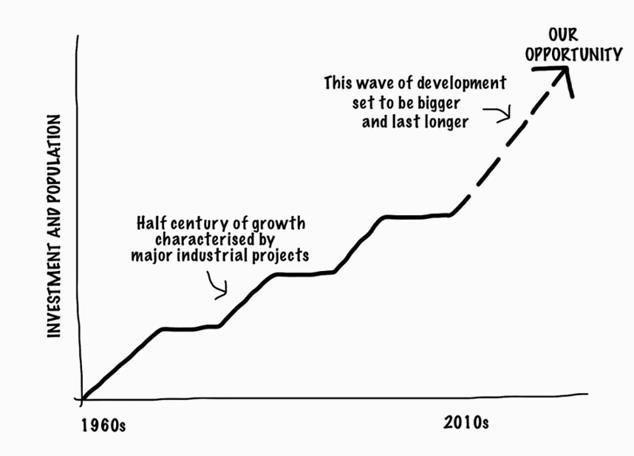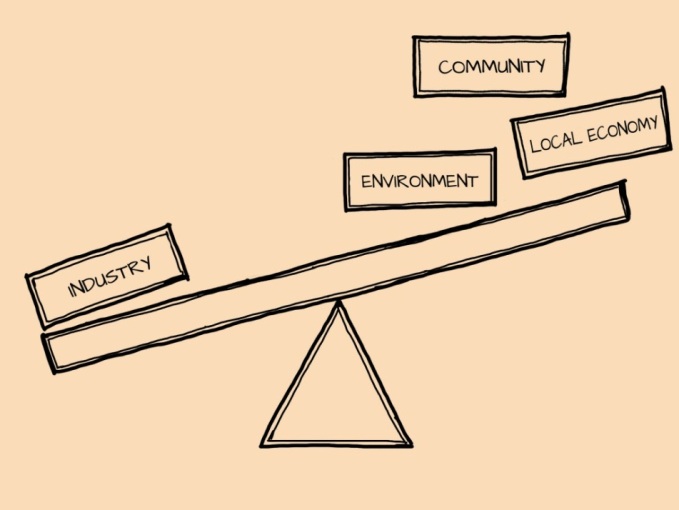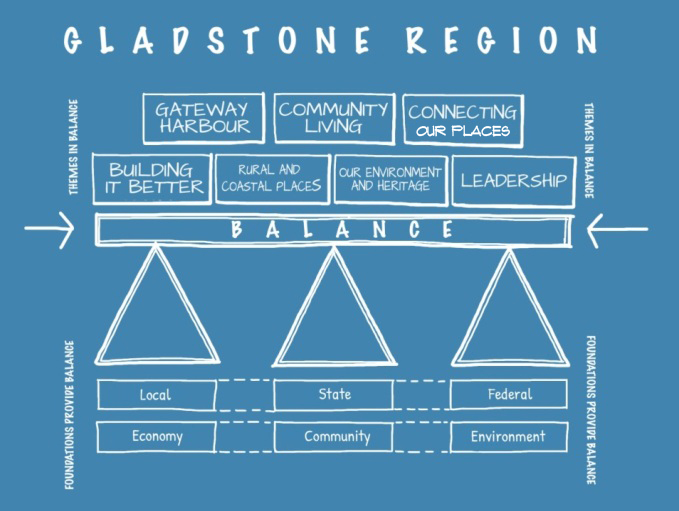Version 2 - Current Planning Scheme
- Citation and commencement
- Part 1 About the planning scheme
- Part 2 State planning provisions
- Part 3 Strategic framework
- Part 4 Local Government Infrastructure Plan (LGIP)
- Part 5 Tables of assessment
- Part 6 Zones
- Part 7 Local plans
- Part 8 Overlays
- Part 9 Development codes
- Part 10 Other plans
- Schedule 1 Definitions
- Schedule 2 Mapping
- Schedule 3 Local Government Infrastructure Plan (LGIP) mapping and tables
- Schedule 4 Notations required under the Planning Act 2016
- Schedule 5 Land designated for community infrastructure
- Schedule 6 Planning scheme policies
- Appendices
3.2 Strategic intent
The Gladstone region story: from now to its preferred future
Gladstone is a region of contrasts. It is made up of places that exhibit different qualities and experiences, different types of growth and planning related challenges. It has long been a major industrial powerhouse of the Queensland economy. The city and its surrounding urban areas have experienced almost 50 years of major industry, port and economic development investment and is a focal point of the Queensland economy. This has led to the rapid growth of a number of urban areas including the city itself, Boyne Island, Tannum Sands and Calliope. The region also includes a large and diverse hinterland with numerous villages and towns in coastal and rural settings.
This growth is built on the area's natural and man–made assets such as the safe deep water harbour, abundant water storage, land, power and limestone, sand and hard rock resources – which underpin the region's emerging role as a global energy hub, exporting coal, gas and shale oil. This in turn has positioned the region as a logical location for value adding industry, plus transport and logistics opportunities to support these roles.
The region has experienced a series of 'booms' associated with major new industry and port development. These booms have seen unprecedented levels of major economic activity related to mining and gas, port operations, and major industry, ranging from the LNG plants on Curtis Island, major port expansion at Wiggins Island, and the development of the Gladstone State Development Area (GSDA).
These booms create tremendous economic development opportunities and also major pressures where this growth is taking place, with less investment occurring outside of these areas. The growth is not plain sailing – it creates significant pressures on other sectors of its economy, urban development, infrastructure, community, services, and the region's environment. The latest boom represents a significant opportunity in Gladstone's history to make the most of this situation for the long term benefit of people living and working in the region, as indicatively captured in the graph below:

Like the urban growth areas of Gladstone, Boyne Island, Tannum Sands and Calliope, the coastal and rural towns and areas are important components of the Gladstone region. Although many of these places are some distance from the high growth areas, it is desirable that the benefits of major resource and industrial related development be shared by the whole region. It is also desirable these places retain their character and lifestyle attributes.
So our overall intent for the Gladstone region is:
Getting the balance right: local benefits from global growth
This strategic intent has two primary aims:
- To recognise that some parts of the region shoulder a major economic load, because of their role in the global economy as a focus for major industrial development, major port facilities, and other related investment which is fundamental to the continued economic prosperity of the State and nation. The community wants to ensure that this global role benefits the Gladstone region as well as the State and nation.
- For the region to be nationally recognised as achieving the best possible balance of large industry, sustainability, community wellbeing and environmental protection. This will be attained through a preferred settlement pattern and infrastructure strategy capable of responding to the needs of major industrial growth surges, and the setting of a development framework that will create a region of vibrant, sustainable and affordable neighbourhoods where residents feel supported and engaged.
This strategic framework is about a 'rebalancing' process, through the planning scheme (and other initiatives of the Council) to achieve great outcomes for the people living and working in the Gladstone region as well as for Queensland.
Conceptually, it is about moving from this…

… to the region's preferred future:

It is in everyone's interest to balance these major economic opportunities with community and environmental aspects, to create a mature region of complete communities which provide genuine choice and support for all its residents, workers and visitors.
This will benefit:
- major industries investing in the region, because it ensures that those who work and live in the area have access to the housing and services they need, and choice of lifestyles which keep them connected to, and happy in, the Gladstone region
- the regional community, because its people have access to lifestyle choices, appropriate housing and essential services
- the regional environment, including those areas of national and state environmental significance, which is protected and can sustain the industry and urban components of the region, and
- Queensland, as it underpins the sustainable economic development of Gladstone as Queensland's premier industrial capital and gateway harbour to the world, thereby providing great economic outcomes for the State in the global economy.
The foundations for these balanced outcomes are:
- the economic, community and environmental components which support the balanced outcome, and
- the efforts of governments at all three levels, (the regional Council, the State and Federal governments) to achieve those balanced outcomes.
This balance is also about providing choice (of lifestyle, employment, housing, etc), integration (between the area's economic activities, community life and environmental values), and sustainability (through the planning scheme guiding the development of the region to outcomes consistent with this overall vision).









